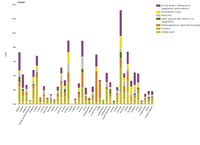
Ground-level ozone adversely affects not only human health but also vegetation and ecosystems across Europe, leading to decreased crop yields and forest growth, and loss of biodiversity. Much of Europe’s lands are exposed to ozone levels above the threshold and long-term objective values set in the EU’s Ambient Air Quality Directive (AAQD) for the protection of vegetation. For instance, after a 6-year period (2009-2014) of relatively low ozone values, the fraction of arable land exposed to levels above the AAQD threshold increased to 30 % in 2015, falling to 19 % in 2016, before increasing again to 26 % in 2017 and 45 % in 2018.


The map shows the long-term impact of water deficit on vegetation productivity, and the area of low vegetation productivity under water deficit impact, aggregated by NUTS3 regions. Negative anomalies are expressed in standard deviation and indicate vegetation productivity conditions that are lower than the long-term average under normal, non-drought conditions.

Monitoring vegetation response to water deficit due to droughts is necessary to be able to introduce effective measures to increase the resilience of ecosystems in line with the EU’s nature restoration plan — a key element of the EU biodiversity strategy for 2030. Between 2000 and 2016, Europe was affected by severe droughts, causing average yearly vegetation productivity losses covering around 121 000 km 2 . This was particularly notable in 2003, when drought affected most parts of Europe, covering an estimated 330 000 km 2 of forests, non-irrigated arable land and pastures. Drought impact was also relatively severe in 2005 and 2012.

The figure shows the rate of growth in the number and cumulative area of nationally designated terrestrial protected areas. Statistics are based on data reported by EEA countries to the Nationally designated areas (CDDA) database.

This database contains a number of climate change mitigation policies and measures (PaM) implemented or planned by European countries to reduce greenhouse gas emissions. Most of these PaMs have been reported to the European Commission, the United Framework Convention on Climate Change (UNFCCC) or the EEA.

The dots represent measurements stations, where the changes have been estimated using UTD monitoring data and the generalized additive model (GAM). The background shading represents the changes estimated using CAMS chemical transport modelling with an emission inventory estimated for the lockdown conditions.

The dots represent measurements stations, where the changes have been estimated using UTD monitoring data and the generalized additive model (GAM). The background shading represents the changes estimated using CAMS chemical transport modelling with an emission inventory estimated for the lockdown conditions

The map shows the average percentage change in NO2 pollution levels from NO2 TROPOMI satellite observations during the period 15th March to 30th April, comparing the observations under the COVID-19 lockdown to the business-as-usual scenario, in European agglomerations with more than half a million inhabitants. The gradient boosting regressor machine learning technique was used to simulate a business as usual (BAU) NO2 tropospheric columns satellite observations.

Relative reductions by country, in 2018 compared to 2009, in the estimated premature deaths (PD) attributed to exposure to PM2.5.

All Member States are requested by the Birds Directive to monitor bird species and send a report every 6 years following an agreed format. This information includes population sizes and trends (short and long term) for breeding and wintering populations, as well as pressures and threats for Special Protection Area trigger species. In addition, population status and trends are assessed at the EU level.

All Member States are requested by the Habitats Directive to monitor habitat types and species listed in its annexes and send a report every 6 years following an agreed format. The assessment of conservation status is based on information about the status and trends of species populations and of habitats at the level of the biogeographical or marine region.

The figure shows the average NO2 pollution level (tropospheric vertical column) from Sentinel-5P/TROPOMI for the period 15 March to 15 April 2019 and for the same period in 2020.

The pan-European High-Resolution Snow & Ice products (HR-S&I) are provided at high spatial resolution (20 m x 20 m), and are derived from the Sentinel-2 constellation data (Sentinel-2A and Sentinel-2B: revisit time 5 of days). They are generated over the entire EEA38 +UK from September 1, 2016 onwards.

New technology and tools are opening up new possibilities for environmental monitoring and analysis. For
example, citizen science, satellite observations, big data and artificial intelligence present opportunities for
improving the timeliness, comparability, granularity and integration of data.

Noise pollution is a growing environmental concern. Noise disturbs sleep and makes it harder to
learn in school. It can also cause or aggravate many health problems. The most important source of
environmental noise in Europe is road traffic.

Plastics have brought many benefits to our daily lives but the problem is that these products never truly
disappear. Therefore, we should perhaps think about plastics as a type of pollutant from the point of
their production and prevent plastic products and waste from leaking into the environment.

Agriculture has multiple impacts on the environment, climate and human health. Unsustainable farming
practices lead to pollution of soil, water, air and food and over-exploitation of natural resources.